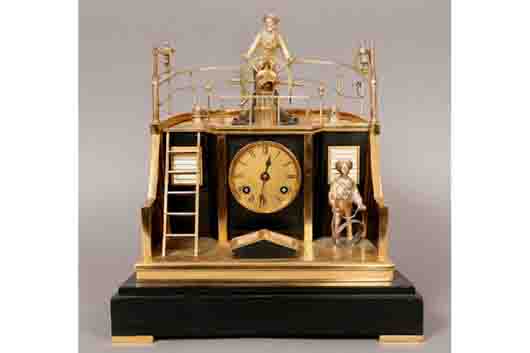
PENDLETON, Ore. (AP) – Thinking about going to clockmaker school? You might have trouble getting in.
Turns out the only full-scale clock school in the country is inside Pendleton’s prison. That was the surprising discovery made about a year ago by the wife of California clockmaker Henri Klein. Viviane Klein decided to give away her deceased husband’s massive cache of clocks, tools and books to a school dedicated to clock making and wanted advice on which one. She called the National Association of Watch and Clock Collectors in Pennsylvania and learned something startling.
“They told me there were no schools left,” she said. “The only school they knew about was in a penitentiary in Pendleton. They got me in touch with Gary.”
Gary was Gary Kopperud, master clockmaker and EOCI instructor who started teaching clock classes at the prison 18 years ago. At the end of training, students receive a certificate showing mastery in the trade. Shortly after Klein’s call, Kopperud received a head’s up from a NAWCC representative that he was about to receive a mother lode of clocks and parts. Kopperud, who also has a design and drafting company, telephoned Klein.
“We struck up an immediate friendship,” Kopperud said. “We discussed all the things Henri had done in his life and how he enjoyed teaching and working in his very extensive shop.”
Klein sent pictures.
“The photos were overwhelming – clocks and tools stacked to the ceiling … lathes, drill presses, several bench grinders, air compressors and on and on.”
And clocks. More than 400 from all around the world. Cuckoos. Hundred-day clocks. Grandfather clocks. Nautical clocks. Regulator clocks. Wall clocks. Mantel clocks. Alarm clocks. Some worked and others didn’t. The collection represented numerous styles and decades.
It was a clock boneyard of gigantic proportions and Kopperud’s mind was officially blown.
Besides the clocks, there were over 60 years of accumulation by the aerospace engineer-turned-clockmaker. A four-car garage, two rooms inside the Klein home and a shed held treasures, plus boxes of clock hands, chimes, pendulums and other clock innards.
Kopperud planned to hire a truck company to bring the gift, but soon got a shock – it would cost about $20,000 to have everything packed and shipped to Pendleton. He started conversations with the Oregon Department of Corrections “to see if EOCI would accept the entire estate and find a way to get it to Pendleton.” It took months of discussions and a mission to California to determine how to crate, wrap and ship the items.
Last fall, EOCI Physical Plant Manager Mike Cleveland sent two men – Tyler Phelps and Tom Moore – to the Kleins’ home in Nipomo, on California’s central coast. The men soon realized they had a big job ahead.
“They walked in and said, ‘Oh, my god,’” Cleveland said. “They spent three days boxing, crating and shrink wrapping.”
The men loaded the clocks and other items into the 20-foot trailer they had towed to California and hired a 53-foot Freightliner semi-truck.
The load went into a prison warehouse, but is slowly making its way into the clock shop. This week, the students grinned as they surveyed an array of clocks from around the world spread out on workbenches and tables.
Inmate Karl Schneidau, a student for the past year, waved his hand over eight nautical clocks made from brass and nickel.
“You would find these on the bridge of a ship,” he said.
Among the dozens of clocks placed around the room were vintage cuckoo clocks, a Westminster mantel clock from 1900 and a Vienna regulator clock from about 1870. Richard Courtney stood near a grandfather clock made in Paddington, England, in 1860.
“When we found out how extensive the collection was, it was amazing,” Courtney said. “We were like kids in a candy store. We are extremely grateful.”
The words would make Henri happy. Klein said her husband had loved the trade so much that when he worked as an aerospace engineer, he spent weekends working on clocks. Later, he opened his own clock shop and he taught others the trade one by one. It disturbed him to see how many clock makers were dying off.
“He wanted new blood,” she said.
Klein’s clocks will likely benefit more than just EOCI students.
“The idea is to expand the program to other (Department of Corrections) facilities,” Cleveland said. “We’re trying to find other volunteers like Gary.”
That could be a tall order. Kopperud, the inmates say, is an amazing teacher who is instilling his love of clock making into them. The master clockmaker is having a hard time believing his good fortune. He enjoys watching the wonder he sees in the eyes of his students as they inspect the clocks from Germany, France, England, the United States, Austria and Switzerland.
“This is poignant for me,” he said. “These clocks are all different. It’s the full gambit of everything that’s out there. That’s an extreme value to a student.”
___
Information from: East Oregonian, http://www.eastoregonian.info
Copyright 2015 Associated Press. All rights reserved. This material may not be published, broadcast, rewritten, or redistributed.
AP-WF-03-01-15 1541GMT


